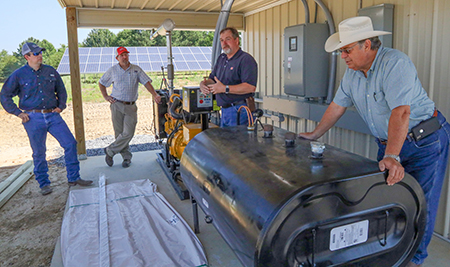Largest Solar-Powered Poultry House Is Operational In Alabama

An off-the-grid poultry house in Cullman County could shine light on new sustainable energy alternatives to help Alabama’s multi-billion-dollar poultry industry.
Auburn University’s National Poultry Technology Center (NPTC) and Tyson Foods Inc. opened the largest stand-alone, solar-powered poultry house June 5. The 54-by-500-foot house holds about 36,000 broilers. It is one of two identical houses on Tim and Selena Butts’ farm. One is the control house, while the other is operated exclusively by solar power, also known as Stand-Alone, Solar For Poultry (SASP).
“Auburn University’s NPTC will work closely with Tyson Foods and Southern Solar Systems to provide leadership in the application of solar power technology to broiler production houses,” said Paul Patterson, dean of Auburn’s College of Agriculture. “The research will provide important, new information on how solar power technology can improve environmental sustainability and profits for farmers.”
The house’s power comes from three components: the photovoltaic (PV) panel or solar cell, a battery set and a generator. For 12 months, on-site researchers will compare its energy use regularly with the normal operation of the twin house next door. The project data is expected to be an important step in identifying sustainable practices and new forms of energy for the poultry industry.
“Ultimately, this project will allow us to identify how solar houses might improve farmer profitability and bring increased efficiency to the poultry industry,” said Chip Miller, vice president of poultry live operations for Tyson Foods. “Through our partnership with Auburn University’s NPTC, we are creating a model for the future of the industry — one that is more sustainable and brings critical value and insights previously unavailable to poultry farmers.”
The combination of solar and batteries, along with other technologies, converts power to usable alternating current (AC) that’s identical to grid power, said NPTC’s Dennis Brothers, an Alabama Cooperative Extension System specialist.
“Electricity drives all functions in poultry houses and is the largest variable cost for poultry farmers,” Brothers said. “We believe this new system may reduce costs for farmers while increasing efficiency.”
Rising electricity costs, coupled with the unpredictability of long-term grid power, created the opportunity for Tyson Foods to explore solutions to help alleviate the effects of climbing prices.
Alabama Farmers Federation State Poultry Committee Chairman Joe Murphy and other state committee members visited the Cullman County test farm earlier this year.
“It’s an impressive project with lots of potential,” said Murphy, a Pike County poultry producer. “Farmers try to do whatever we can to control costs, and this research will go a long way in determining if solar power is feasible. I appreciate the NPTC working with integrators to help find ways producers can reduce costs.”
Miller said Tyson is eager to evaluate the efficiency of the solar house and its impact on farmer profitability.
“We expect this pilot to be the first of many as we continue to leverage the power of collaboration to drive progress in the poultry industry,” Miller said.
